
Imagine going into a fast food joint. You ask for the price of a burger and you are told it is $1,000 per 1,000 burgers.
"It's a bargain! We have a sale going on" the server says. "Drinks are cheap too," she adds. "It costs only $10 per gallon for the beverages, and the ice cream is only $2.50 per liter."
You look on puzzled. Why on earth did she just give you the price of beverages and ice cream in different units when they cost the same thing, you wonder?
"How much are the chicken nuggets?" you ask.
"We don't call those chicken nuggets" the server replies. "We call them 'mashed up chicken crap' – that's what they really are, you know."
"Those are $5 for a pack of 10, or as my pricing sheet says, its $500 per 1,000 pieces."
Absurd as this example might seem, this is exactly what we do in the water industry.
Read about the 4 major pricing problems we have in the industry.

Pricing must be relatable – that is marketing 101. When we price in units of $/1,000 gals we are using a unit of consumption that is not natural to a consumer. How many people can conceive of a 1,000 gallons of water? Is that the size of a swimming pool, or a bath tub? How many cups of water make up 1,000 gallons? The relevance and relatability principle is what makes jewelers sell diamond in carats and not pounds, gold in ounces and not tons and oil in barrels and not gallons. What do the marketing pros do? Well, they sell water by the bottle, or by the liter – both relevant and relatable consumption units. No wonder, bottled water at about $0.25 to $1 per liter (i.e., about $1,000 to $4,000 per 1,000 gallons), costs about 200 to 800 times more than tap water, which is priced at about $5 per 1,000 gallons on average!
Water has always mostly been managed by public utilities that were for the most part okay with operating at a loss. In fact, for most of the last century, water was priced to simply allow utilities to cover their operating cost. The result was a focus on "visible" operating costs and the neglect of buried infrastructure like collection and distribution system assets – pipes, pumping stations, etc. Now that governments are finding it difficult to keep up with water treatment costs and private players are coming in to manage operations at some reasonable return, shifting to a value focus is challenging.
Water is a global industry. You would not know that if you simply looked at how we price water. In the US, the price is in $/1,000 gallons. In the rest of the world it is in $/m3. 1,000 gallons is about 4 times larger than one m3, so off the bat, there is a 4 fold difference between US and global water prices, at face value. That's not all. Water rights are priced in $/acre-ft. (what the heck is that?). And then of course, bottled water gets sold by the liter or the gallon.
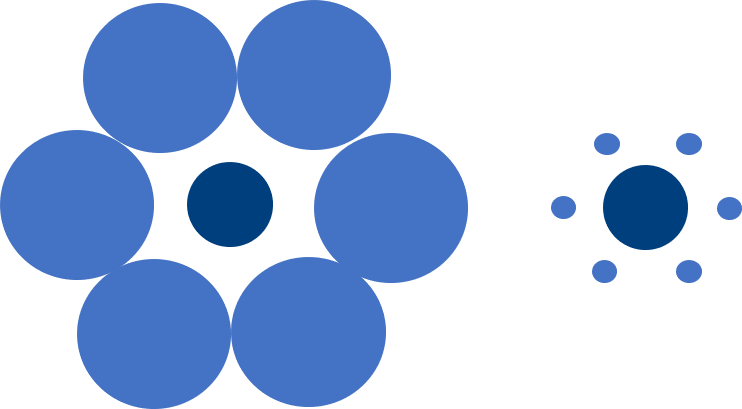
Which orange circle is bigger? Comparing them is difficult when their surroundings are different.(They are actually the same size.)
It's damned hard to sell water. Everyone needs water, but most people also believe that they already pay too much for water. People pay more for cable than they do for water. When I talk to folks, 9 times out of 10, they can't tell me what their water charges are, but they know exactly how much their phone charges and cable bills are. The water industry might struggle to convince rate payers to pay $5 per 1,000 gallons for clean tap water, but Coca Cola charges about $15 for a 24 X 500 mL pack of Dasani – their bottled water brand. That's a whopping $5,000 per 1,000 gallons in water pricing jargon! This price premium persists even though many consumers can't tell the difference between tap and bottled water and in many cases, there are no major quality differences between the two. The few additional steps that might be added to transform tap water into bottled water certainly don't justify up to a 1,000X premium!
Most bottled water production starts with tap water (see Figure 1). The couple of added steps (see Figure 2) certainly cannot justify a 200 – 1,000X price premium! So, how do they pull this Jedi pricing trick off? The difference is value communication. Coca Cola and other sellers of water know how to do it. The difference is value communication. Coca Cola (Dasani), Pepsi (Aquafina) and other sellers of water know how to do it. They name their products and brand them right. Coca Cola doesn't tell you that Dasani is purified tap water. No. No. No! Pepsi doesn't just call its product "Purified Water" and end there. They name them. They brand them. They tout the benefits of the products. They package them well. And they do whatever it takes to let the world know that they have a safe, reliable, healthy product. They communicate value effectively - and that's why they command a price premium. Some of those lessons can be applied to our industry. Apart from a few news junkies, how many people know that tap water beats bottled water in a number of taste tests?

Figure 1: Typical Water Treatment Steps: Drawn in Hydromantis' WatProTM Drinking Water Model

Figure 2: Water Treatment Steps for bottled water: Drawn using WatProTM Drinking Water Model
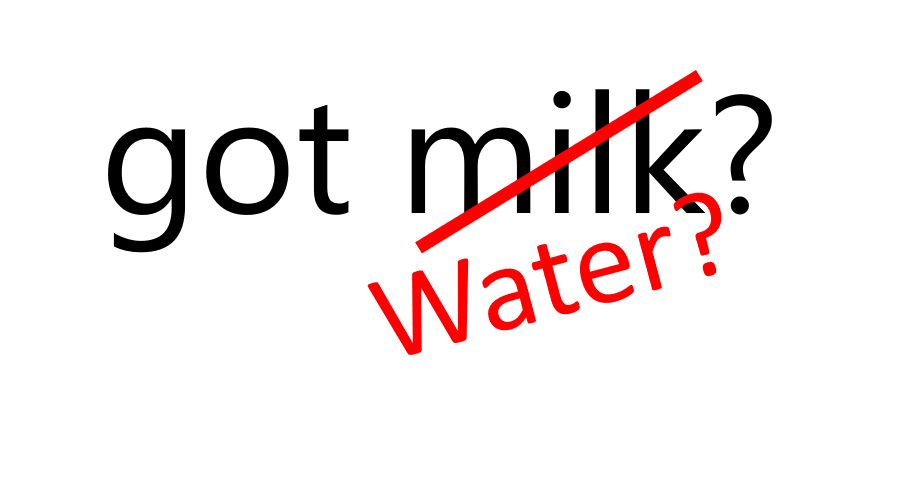
We need an industry wide effort to get our pricing and value communication right. Water needs its own "Got Milk" moment.
For those who don't remember the "Got Milk" campaign, in the early 1990s the dairy industry was suffering from a crisis of relevance. Americans were moving milk out of their refrigerators in favor of other breakfast beverages. The industry realized it had a problem. Faced with an existential crisis, the dairy industry came together, hired a great advertising agency that conjured up the "Got Milk" campaign and reintroduced milk to America. That effort transformed milk into not just a desirable product but also a sexy product.
We need to transition from our industry's cost based mentality into a value based mentality. Utility leaders and water trade associations must embrace the language of marketing. Engineers need to give way to people who truly know how to sell and market stuff.
We must learn how to price water appropriately. We must learn how to name products. Most of all we must learn how to communicate value.
If we succeed, then water will certainly be worth it!
What regulatory targets keeps operators up at night? What operational issues are they most concerned about, and how do they find solutions to pressing operational problems? We posed these questions to the top wastewater operators in the United States - all of whom participate in the most popular operator challenge in the wastewater industry – the Water Environment Federation (WEF) Operations Challenge.
Their answers were revealing. By far the most interesting result and insight we obtained was that operators make decisions mainly by troubleshooting. This flies in the face of industry practice - where consulting engineers spend countless hours preparing operational and process manuals that the operators typically don't use.
Read on to learn more about this fascinating subject.

We asked the top wastewater operators in the United States a set of simple, but profound questions on three themes:
1. What regulator imposed water quality goals their facilities have to meet.
2. The biggest operational issues they have to deal with.
3. How they make decisions when faced with operational challenges.
Their answers were revealing. By far the most interesting result and insight we obtained was that operators make decisions mainly by troubleshooting. This flies in the face of industry practice - where consulting engineers spend countless hours preparing operational and process manuals that the operators typically don't use. To meet its pressing challenges, the water industry must adapt its process support tools in ways that make sense to how operators truly learn and act.

Wastewater facilities are faced with a broad range of regulator imposed limits, ranging from reducing organic loading (BOD and COD) to reducing nutrient limits (Nitrogen, Phosphorus) and ensuring that discharged effluents meet basic dissolved oxygen requirements (DO).
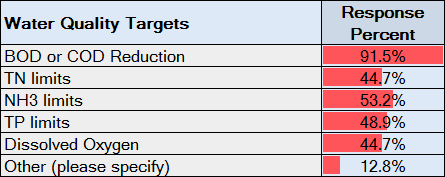
Operators are faced with many challenges that come from forces that they have no control over. In addition to worrying that their aeration systems, blowers, pumps, pipelines and decanters are functioning, operators must also deal with climate and weather related issues (rain, temperature, storm water). They must also worry about what is contained in the wastewater that the industrial dischargers in their sewage catchment area are doing. By a mile, storm water and rain events were the biggest worry for the operators, followed by cold temperature concerns.

How do operators deal with operational problems? Do they read the process manuals that consulting engineers provide to them? Do they go to their supervisors and ask for guidance and direction? Do they discuss with their peers? Or do they roll their sleeves up and try to figure things out by troubleshooting? Operators are doers. About 55% of the operators indicated that their first instinct would be to troubleshoot the problem.

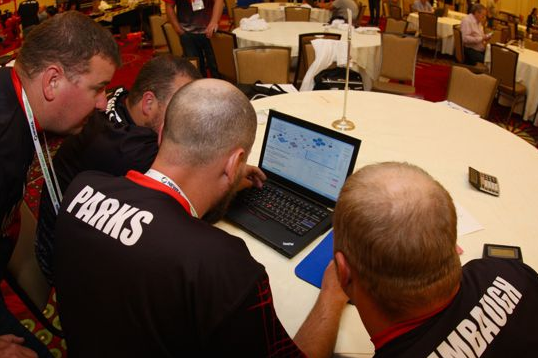
An Operation’s Challenge Team Working on the Simulator Platform
It turns out that our industry has not been providing operators with all the tools they need. It has always been recognized that operators learn by apprenticeship. They attach themselves to a more seasoned operator that they occasionally consult for support – and this explains the 18% that indicated they discuss with their peers. But who would have guessed that so many would rather troubleshoot a problem by themselves?
Zero - not one of the respondents indicated they read the process manuals that consulting engineers spend so much time putting together! None. Why then do we spend so many engineering hours developing manuals that aren't used? The issue is not with the manuals. The knowledge they contain is important. The problem is that they are just not put together in a form that is relevant for how operators learn or work.
Troubleshooting process issues in a regulated industry can be immensely challenging. While testing and probing for an optimal solution, the operator has the burden of still ensuring that the facility's water quality goals are met.
So, how can we empower operators to troubleshoot effectively, while ensuring that the facility's water quality goals are not put at risk?
Simple. We do what the aviation and nuclear industries have done for decades - provide operators with realistic 3D process simulator platforms that can allow them to evaluate scenarios in a virtual environment. These simulators account for all of the biological, kinetic, hydraulic and equilibrium chemistry models that underlie wastewater treatment embedded in a powerful mathematical model.
Hydromantis has had the great honor of working with WEF to deliver a high fidelity 3D process simulator for the WEF Operations challenge. Operators have taken to the simulator platform with excitement. Some have even likened it to a video game. We have had some operators ask if we could provide Smartphone APP versions of the simulators.
Three of the most spectacular success stories in technology adoption in the water & wastewater industry include:
1. The roll out of the Union Carbide (UNOX®) high purity oxygen activated sludge process which treats about 6 billion gallons per day (15% of US wastewater treatment capacity!)
2. Cambi's breakthrough in the United States with the adoption of their version thermal hydrolysis process at the 370 MGD Blue Plains Advanced Wastewater Treatment plant and
3. Stickney Water Reclamation Facility's (1 billion gallons per day) adoption & recent commissioning of the Ostara phosphorus recovery process.
In each of these cases, massive wastewater facilities have adopted technologies at scales that are as high as over 100 times the size of current pilot or commercial scale installations.
Read on to find out the back story to how these innovative technologies crossed the chasm and got big wins in the water market.
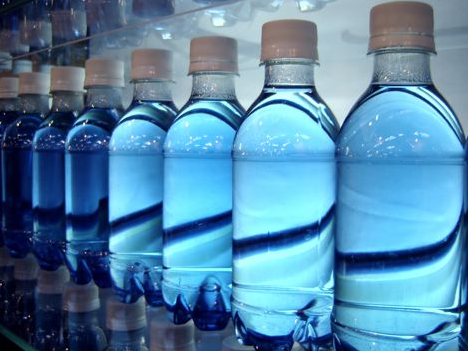
This is the oldest of the success stories, and it goes back to the late 1960s. In 1967, a young Engineer at Union Carbide called John McWhirter, came up with a radical new process. At this time only 30% of US cities had secondary wastewater treatment. Many large cities like Detroit, New York and Louisville had no secondary treatment systems, and worried about the footprint that new plants would occupy. McWhirter came up with a simple, but profound technology. Observing that surface aerators provided the oxygen needs of a wastewater plant by spraying water droplets into air - with 21% oxygen, he recognized that if the atmosphere above a wastewater plant could be converted to 100% oxygen, then up to 5 times as much oxygen could be dissolved by the same surface aerator, in the same footprint. Meaning, an activated sludge plant could provide as much as 5 times the treatment in the same space if it had a high purity oxygen headspace instead of air. Fascinating stuff!
This was great news for land challenges cities - but it was a radical idea and it met with some initial resistance. The first pilot scale systems started up in 1967 and by 1970, the City of Detroit had signed up to build a 720 MGD facility.
The major pushback from utilities and consulting engineers was the lack of experience with the technology and little understanding of the process. In partnership with the EPA and a number of test sites, a set of design and operational guides were published in 1973. The guides provided extensive details on how to size the plant, the impact of pure oxygen on plant operations, clarifier operations, cost, sludge microbiology & solids settling. It essentially provided enough information to let anyone considering the process understand its plant wide impact. The effect was tremendous - adoption shot up. Pure oxygen wastewater plants made up over 20% of all new wastewater plants constructed in the 1970 - 2000 timeframe. Today, pure oxygen based activated sludge systems treat about 6 billion gallons of the 38 billion gallons of municipal wastewater treated daily in the United States. Technology adopters include Detroit (720 MGD), Middlesex (250 MGD), Los Angeles Hyperion (450 MGD) and many others.
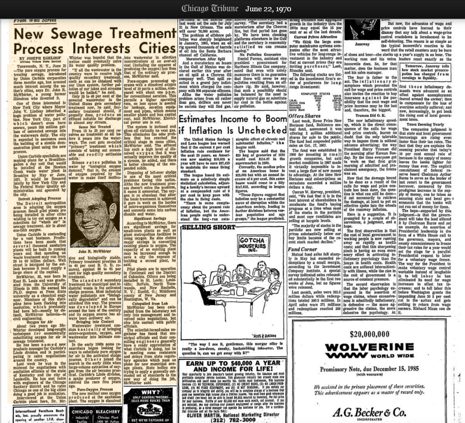
Chicago Tribune Article on the UNOX® process from 1970
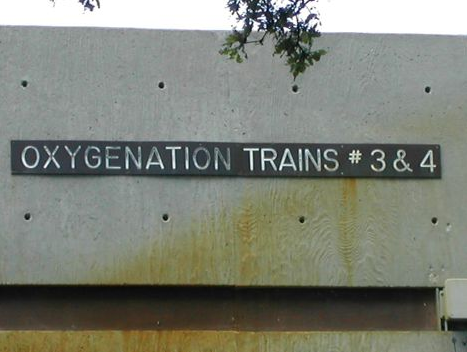
Sign on Treatment Trains at Miami Dade Oxygen Activated Sludge Treatment Process
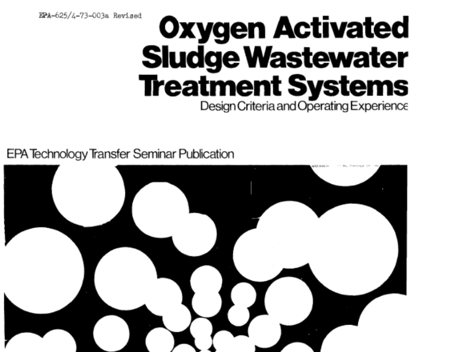
Title page of 1973 Design Guide Released by the EPA on the Pure Oxygen Activated Sludge Process
As interest has increased in recovering more biogas and energy from sludge in anaerobic digesters, a number of innovative technologies have been developed to enhance the digestion process. Only about 30-40% of the energy locked up in a bacterial cell is released in an anaerobic digester. Thermal hydrolysis uses heat and pressure to “burst open” bacterial cells, releasing their energy content for conversion to biogas.
From its origins in 1996, the Cambi thermal hydrolysis process had made some modest progress in Europe, but it made few in roads in the attractive US market. By 2012, its largest sized plants averaged about 30,000 dry tons of solids per year. It turns out that the larger a plant is, the more sludge it has, and therefore, the more biogas and energy it can potentially recover. But, with increasing size comes increasing risk. Operations can get more challenging, higher ammonia levels could potentially inhibit digester performance, and larger recycle streams could potentially compromise effluent quality - jeopardizing the plant's ability to meet its regulatory limits. Unless these questions could be answered, adoption would have to remain slow and tortuous - subject to extended pilots at each plant.
In 2008, a paper was presented with little fanfare at the Water Environment Federation conference. It was titled “Simulation of Thermal Hydrolysis at the Blue Plains AWT: A New Toolkit Developed for Full-Plant Process Design” - authored by some leading researchers, plant personnel and modelers. It was not the first paper to report on pilot scale thermal hydrolysis studies. But it was one of the first to present a useful modeling framework for handling some of the most vexing questions about the risks involved with the implementation of thermal hydrolysis. Within a couple of years, all the major modeling platforms (Hydromantis and others), had integrated thermal hydrolysis modules into their simulation platforms. This allowed anyone - utilities, consulting engineers, and solutions integrators - reviewing thermal hydrolysis to develop full pant models that would allow then understand the full plant impact of adopting thermal hydrolysis. The results have been impressive. In 2014, Cambi announced that DC Water's massive 370 MGD Blue Plains facility, with annual dry solids of about 140,000 tons per annum would be the first plant in the US to adopt the Cambi process. Since then, the big wins have piled up for Cambi.The company has signed a number of mega deals around the world, a number of which are at the massive scale of the Blue Plains plant .
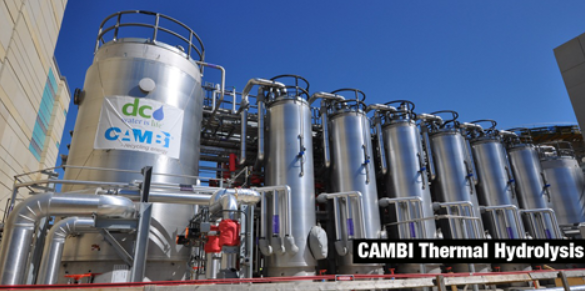
Cambi reactors at DC Water Blue Plains Wastewater Treatment facility
Just last week, the 1 billion gallon per day Stickney Water Reclamation Facility unveiled the world's largest phosphorus recovery plant. The facility is based on Ostara's Pearl® technology and allows the recovery of phosphorus and ammonia as a high grade fertilizer from concentrated waste streams. It was cheering news in an industry that doesn't get a lot of opportunity for celebration.
How did this happen? How did Stickney - arguably the world's largest wastewater plant, come to adopt a technology which had never been installed at a plant larger than 40 million gallons per day prior to the Stickney project?
Phosphorus recovery like other innovative technologies, can have impacts beyond the point of application of the technology. The process can result in a change in recycled nutrient flows and solid flows. Facilities need to understand the impact of process failures in non-essential processes like nutrient recovery on the plant's ability to meet its regulatory limits. In order to understand the implications of adopting the Ostara process on their facility, Stickney commissioned a process modeling study in 2014 that was carried out using Hydromantis GPS-XTM simulator. The simulator allowed them to develop a plant wide model of the facility. Using this platform, they could run different scenarios and evaluate the impact of different operational regimes on the Phosphorus recovery process, and vice versa. This tool allowed the risks to be better understood. It validated the scale of the opportunity and enabled Stickney to develop a coordinated plan for adopting this innovative technology.
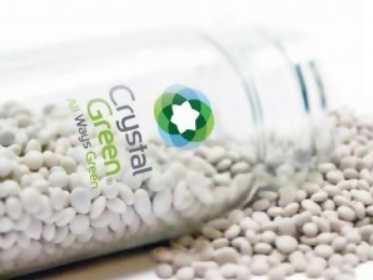
Ostara's Crystal Green Fertilizer recovered from wastewater
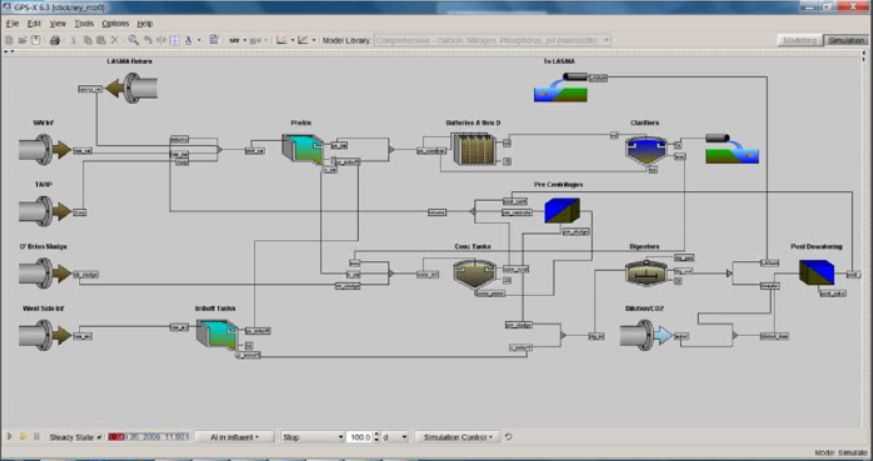
Stickney plant wide model for Struvite recovery developed in Hydromantis' GPS-X(Source: Koch et al, Phosphorus recovery at the Stickney Water Reclamation Plant. MWEA 2015 Annual Conference)
The water & wastewater industry has generated a lot of investment interest and activity over the last decade. It is estimated that in the 4 year period from 2010 to 2014, venture firms invested $1.4 billion in about 400 water technology companies. Despite this massive influx of funds, few water startups or water focused innovative technologies have been successfully commercialized.
Read on to learn more about the 5 major pitfalls that trip water firms and how process modeling can help them navigate the commercialization voyage.

The investment interest in water is not surprising. Water is without a doubt the most undervalued and under appreciated critical resource available to human kind. It is plentiful – 70% of the earth's surface is covered in water. But fresh water – the type that is in rivers, stream lakes, and in groundwater reserves – which is what we typically use as a source for drinking water, makes up only 1% of all the water available on earth.
The other 97% of water on earth is brackish, salt laden water. If sufficiently treated to remove the salt, it is also fit for human consumption, but the cost of treatment is high – about 10-20 times higher than the treatment costs for freshwater. As the ancient mariner once said, there is "water, water everywhere, but not a drop to drink." Freshwater is what is in demand and there is an awfully small amount of that available.
The water crisis is made worse by rising population, extended droughts, increasing urbanization, climate change and other factors are affecting the availability and access to fresh water reserves. It has been projected that the conflicts of the future will likely be driven by geopolitical interests that are centered on access to fresh water reserves.
The opportunity for investments in water lies in five key areas – minimizing losses in the water distribution system, reducing the overall cost of treatment for water & wastewater, enhancing safe (waste)water reuse, promoting conservation & sustainability and utility operations.
Utility operations has been an area of extensive investment activity in water for decades. The activity of startups and new technology development efforts has been in the other 4 opportunity areas.
Another way to think about water sector technologies is to think of them as demand or supply side applications. Demand side tech are focused on the end user. They include APPs, software, or metering systems that help consumers track their water usage, compare their consumption to others', monitor usage costs and benchmark their carbon footprint. Supply side applications are focused on the treatment and delivery systems that are used for treating drinking, process or wastewater. They include enhanced separation, aeration, disinfection and collections systems technologies. They are intended primarily to increase revenue opportunities for utilities and/or reduce the cost of water treatment.
Over the last decade, a number of "gate keeper" tech evaluation and Accelerator programs have emerged in the industry, with the stated aim of working to streamline the massive deluge of startups and technology development activity in the industry. These efforts such as the Artemis Top50, Imagine H2O challenge, etc. have allowed investors to identify startups that are bringing cutting edge technology solutions to the water sector.
The primary mode of operation for these Accelerator initiatives has been the staging of challenges and the provision of access to venture funds and growth supporting resources for promising firms. ImagineH2O for instance claims that its accelerator participants represent 1 in 10 dollars of early stage investment in the water industry since 2009..
While there is no shortage of information on how much money these accelerator and innovation tech competition programs have allowed their participating firms to access, what is not as readily available is the success rate of these firms.
As the largest developer of process modeling & design software in the water & wastewater industry, we have a front row seat to all of the cutting edge action taking place in the water space. After all is said and done, any successful supply side technology must become integrated into a process modeling & design platform. The consulting engineers who implement the technologies and the operators who run them want to know what the implications of these techs will be for their overall operations. Firstly, they want to be sure that their ability to meet their permit requirements will not be compromised by the new tech. Secondly, they want to ensure that their operators are able to operate the new technology systems or processes. And finally, they want to understand how the technologies will be impacted by rare, but typical occurrences such as storm events, equipment failures and shutdowns, etc.
In addition to serving as a final integration point for innovative technologies that break into the mainstream, our principals have over 30 patented water technologies and decades of water tech commercialization experience – so we know how innovative technology works in the real world of water & wastewater treatment. We are one of a handful of firms that get the call from the utility that wants to know how a tech that has been proposed to them will fit in their plant; or from the technology provider that finally realizes that without developing a process design model that lays out the fundamental mechanisms of how their technology works, they will be not make headway with the engineering community that utilities turn to for support when adopting new tech.
These are the five major pitfalls that we see standing in the way of companies and technologies that struggle to gain traction in the water industry:
It is hard to believe but there are firms out there that simply do not seem to grasp the fundamentals of how their tech operates. Without understanding the underlying mechanism of what makes your technology work, field trials become a crap shoot. Too many technologies sound like voodoo.
Water is pretty straightforward. Yes, there might be a heck of a lot of different organic or inorganic contaminants that need to be treated, and maybe a ton of microorganisms that facilitate the process. But the science that underlies the treatment process is pretty robust. Here's a simple guide. If the underlying reason for why your tech works cannot be explained and grasped by a fairly technically literate person in the field then you have a problem. If you cannot predictably understand how your technology will scale across flow and organic loading conditions, then you have a really big problem.
Finally, if you cannot predict whether you will succeed or fail in a pilot based on your knowledge of the fundamentals of your process then you certainly do not have a technology that will inspire confidence in a regulated environment like the water industry.

In the water industry, you don't get a prize for being the most innovative water or wastewater utility. You get brownie points for being consistently on point - meeting your regulatory permit limits and providing a safe product to your rate payers. You can have the greenest and lowest carbon footprint facility, but if you have lead or Microcystin (algae toxins) in the water, or excessive organic matter in your wastewater discharge, you have failed.
This implies that the water sector has few analogies to the consumer goods markets where early adopters are ready to pay more for an innovative product – even if it has some quirks and rough edges. The idea of disruptive innovation also has a different threshold of acceptance in the utility business. A disruptive innovation can have one very promising feature but some "not so great" features when compared to the alternative. Think about digital cameras. The first ones off the shelf had poor picture quality and long shutter lag. But they offered the convenience of not requiring development, and being able to hold lots of images on a portable drive. In the utility industry, the innovation can lag in any other area (cost, operator oversight) except one – it must never, ever compromise water quality. Also, unlike other business where the bottom line comes down to profitability alone (reduce cost, increase revenues, or both) the winners in the public utility industry are those who can consistently meet their limits - all else is extra.
What are the implications of this compliance focused outlook? It implies that an innovative tech must be rock solid. You have to know its strengths and its failings. You must have some pretty good sense for what it will do in the field. If it is a filtration based technology, you will need to understand how different constituents in the water might impact fouling rates or membrane life. If it is a disinfection product, you must have a firm grasp for how variables like flowrate and organic loading affect performance.The utility industry is a cautious one that expects you to pay in most cases to trial your innovation. And by the way, the trials should be at a scale that counts. Knowing your sweet spot in terms of utility size can help you select the right trials. Organizations like Water Environment Research Federation (WERF) and Water Research Foundation (WRF) have programs that match innovative tech provider with utilities that are willing to provide their facilities for pilots and trials in the wastewater and drinking water treatment industry respectively. On the industrial side, organizations like Petroleum Environmental Research Forum (PERF) offer similar trialing opportunities.
In the United States where much of water & wastewater treatment is still public, there is significant scrutiny of investments. It is hard for utilities to raise money for new and "untested" technologies. Also, there is a culture within the industry of only trusting data that comes from one's own plant. With each pilot test taking from a few months to years, and with the skills shortage at many utilities – the bar is quite high. Innovators should seek opportunities to participate in these multi-facility, industry supported trials wherever possible. It saves time, resources and effort. Because these trials also involve engineering firms and consultants, a major hurdle to adoption is also addressed at the same time as the onsite validation.
If you are really sure about your technology, and your innovation is not regulation critical (e.g., a new aeration technology, a novel dewatering technology or smart control and monitoring system) then you might want to attempt a bold strategy to finance the adoption of your own tech. If it works, the utility adopts. If it fails, you take it out at your own cost. Few utilities that have a real need ever turn such an offer down. But doing this requires really knowing what your odds for success will be.
In almost every utility where my colleagues and I have trialed new technologies, there is no end to stories of failed trials that they had embarked on before. The industry's legendary caution with new tech will be better understood when viewed from this context.
Again think about it – we have had record sums of money being invested in water startups over the last decade, but where are those winning technologies? How many have found adoption in the utility sector beyond ta handful of trial sites? On the supply side, we are certainly not seeing as much growth in uptake of new tech commensurate with the activity on the investment side.
I have never seen any assessment of the fate of the companies that were past recipients of the Artemis Top50 or the Imagine H2O awards. We know many of these awards recipients have been successful in raising funds – the award hype helps - but how well have they fared in successfully deploying their technologies and rolling out commercially? What is the real track record of the accelerator programs? How have water startups fared compared to those on the social media and enterprise solutions side?
Raising funds and attracting investors is only the first step in the journey to success in the water and wastewater sector. The next and most important step is to get one's technology adopted – and to go commercial. That is where the failures rack up. Many of these technologies make sense in the lab, but fall short in the field.
It should be obvious by now that taking care of PITFALL 1 reduces the risk of seeing failures during field pilots. Success requires that you know the fundamentals, and develop robust models for how your tech will perform in the field.
I am often amazed by how little innovators and technology developers know of competing technologies. Water and Wastewater industry is global. Chances are that whatever brilliant technology you have come up with addresses problems that are already being solved in the industry, in some way. This has to be the case because it is a regulated industry and whatever that problem is that the facility needs to meet in their permits – they are more than likely already in compliance.
A new technology might provide value through a cost reduction angle, enhance revenues (e.g., by alerting to non-revenue water lost through leaks, etc.), or provide a sustainability advantage such as lower carbon footprint. Or better still, combine elements of enhanced profitability and sustainability. Too many tech providers cannot tell you what the competing alternatives are for their innovation. They know their own costs pretty well, but make all kinds of assumptions – and you can guess, non-flattering ones – about how the competing alternatives work.
They cannot tell you what plant wide effects their technologies will have, what the impact on plant operations will be, or what specific differences in treatment efficiency can be expected by adopting their tech vs others. This is always a recipe for disaster. A field trial shouldn't be the place to learn these details. The tools already exist for assessing competing costs and operational impacts. Tools like CapdetWorksTM, provide plant designs as well as capital and operating cost information, to within ±15% accuracy while process modeling and design software allow the robust determination of plant wide operational effects.
Markets are different – what works in one geographic area, or one sector (e.g., industrial vs municipal; public vs private) may not work in others. The US utility market is largely public. Although private sector actors like Veolia, American Water and United Water (Suez) are increasingly taking on contract operations of public utilities, majority of US utilities are still public sector financed.
Another key feature of the North American market is that consultants rule. Nothing gets done without consultants. No technology gets adopted without the blessings of consulting engineers. Consultants do not have as much say in Europe or in China. In Europe, where privatized utilities have existed for over a century, much of the expertise that consultants provide is available within the utilities themselves. Utilities in Europe are more open to adopting innovative technologies, and continent wide frameworks like the Framework Program (FP) for Research & Development provides significant funding for innovative tech trials and encourages collaboration between academics, innovators, startups and more established firms.
In Europe, many utility contract operators are massive construction and environmental technology conglomerates with annual revenues in the billions of dollars (e.g., Acciona, Agbar, Veolia, Suez). They have large R&D budgets that rival what many top universities spend on environmental studies and have access to a large number of facilities that they operate, and can use for their trials. Because they are in it to make money, they are also open to non-internally developed technologies. The large size of the contract operators and their generous resources also implies that facilities have a network of expertise they can tap into to manage any teething issues with innovative technologies.
However, success in Europe does not translate to success in North America. If you are trying to break into the North American market, then you must understand that consultants are gate keepers. They don't get paid for being innovative. They get paid for being right. Accessing consultants cost money. And any post installation support of an innovative technology will more than likely also require that the utility pay for the services of the consultant. No technology can make headway in the US without consultants being comfortable. That means they must be convinced of its efficacy and confident that there will be no surprises if they recommend it to their clients. This makes the availability of robust process models more important in the US than the European market.
Models can help make technology adoption SURE by allowing for:
In the chemical process industry no new technology can be adopted without first using process models to replicate its pilot scale performance and then on the basis of that, developing full scale plant models.
Water and wastewater treatment should be no different. In the last 30 years companies like Hydromantis, WEST (DHI), Envirosim and others have extended and enhanced the capabilities of process models for handling the complex hydraulic, biochemical and physical chemical processes that take place in water and wastewater utilities.
At Hydromantis our simulators have been used for the last three decades by consulting engineers for upgrading and designing new water & wastewater plants, regulators pricing the cost of new environmental standards, and by inventors seeking to know how their technology stacks up when compared to existing alternatives in terms of both performance and cost.
Models enhance predictability – a key attribute necessary for a utility focused technology. For instance, during a trial, a model can alert to the fact that there might be an initial acclimatization stage during the pilot when a facility might struggle to meet its goals as the microorganisms acclimate to the new process conditions. Without a process model, this event might seem like an anomaly, causing both surprise and concern that things are going wrong – sometimes prompting trials to be shut down just before they succeed.
Process modeling software are not the magic bullet that will solve all the world's problems – but they can and should play a more important role than they currently do in our industry.
Table 1: Major technology & investment focus areas in the water & wastewater industry, and the role that process models play in enhancing technology adoption
| Investment Focus | Comments | Drivers | Technology Focus (examples) | Role of Process Models |
|---|---|---|---|---|
| Minimize water losses | Reduces estimated losses of 10-30% of treated water in delivery pipelines. | Reduce non-revenue water and eliminate wastage. | Smart meters, leak detection, data analytics; smart irrigation systems | N/A |
| Reduce the cost of treatment | Targets reduction of energy, chemical and operational costs for water & wastewater treatment | Enhance viability of private water operations; Reduce the cost of brackish water treatment | Novel materials that reduce membrane fouling; Energy recovery & reuse processes; Nutrient recovery | Technology evaluation; cost comparison; full plant effect |
| Enhancing safe direct potable water reuse | Reduces evaporative losses of treated wastewater returned to surface waters; potentially reduces cost for water treatment | Address water scarcity challenges through reuse of treated wastewater; minimize pressure on raw water supply; potentially reduces treatment cost | Tertiary treatment; disinfection; removal of micro pollutants | Cost evaluation; fate & transport of key contaminants; scale effects |
| Promoting conservation and sustainability | Reduces the volume of water usage; minimizes energy use, carbon footprint and/or greenhouse gas emissions | Demand side applications aimed at cost reduction and/or enhancing environmental stewardship | Demand usage monitoring systems; carbon footprint estimators; energy efficient tech | Quantification of sustainability impact - carbon footprint, resource recovery; implementation cost |
| Utility Operations | Involves the privatization of public water utilities and/or the contract operations of industrial water assets | Enhance operational capabilities of privatized operators; enhance profitability of utility operations | Operations enhancers - minimize non-revenue water losses; energy efficiency; resource recovery and reuse; tech enabled operations | Operator training; evaluation of plant wide effects; tech implementation costs |
There are two big changes taking place in the environmental utility sector. Firstly, tighter regulations are leading to increasing complexity in utility operations and secondly, the baby boomer generation that started out in the industry in the 1970s and 1980s is retiring.
As Utilities struggle to address the new challenges, "Flight Simulator" concepts are increasingly being used to support the training and succession planning needs that are emerging.
Read on to find out how Hydromantis is supporting utilities and organizations in developing solutions that address their needs in this area.
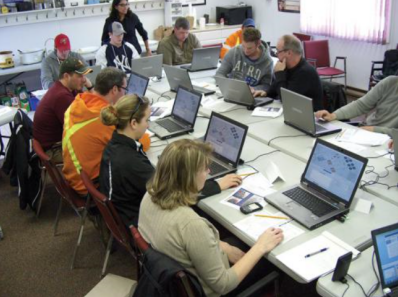
Regulations are changing – quickly and furiously. The activated sludge process was invented about 100 years ago. For the first 80 years (through the end of the 90s), the major focus of wastewater treatment was simply the removal of solids and organic carbon. A well designed wastewater treatment process simply needed to have sufficient aeration to support carbon removal.
Then came the wave of Nutrient removal requirements starting in the late 1990s, as communities in the Mid-Atlantic and North East bordering water bodies like the Chesapeake Bay, Puget Sound, Long Island Sound and a host of other sensitive water bodies started to address the problems that excessive nutrients (Nitrogen and Phosphorus) were having on their precious water resources.
The resulting effect has been an explosion of new technologies and processes. Membrane bioreactors, denitrification filters, biofilm media reactors, thermal hydrolysis, advanced oxidation, granular sludge systems – have now moved from laboratories squarely into the heart of the wastewater treatment process.
On the drinking water treatment side, utilities now have to deal with challenges like eliminating the risk of toxins like microcystin from algae, chlorination byproducts, etc.
The graphic below captures the changes taking place in the wastewater industry – observe the blank spaces in the first 70 years, and then the explosion of regulations and new technologies in the last 3 decades!
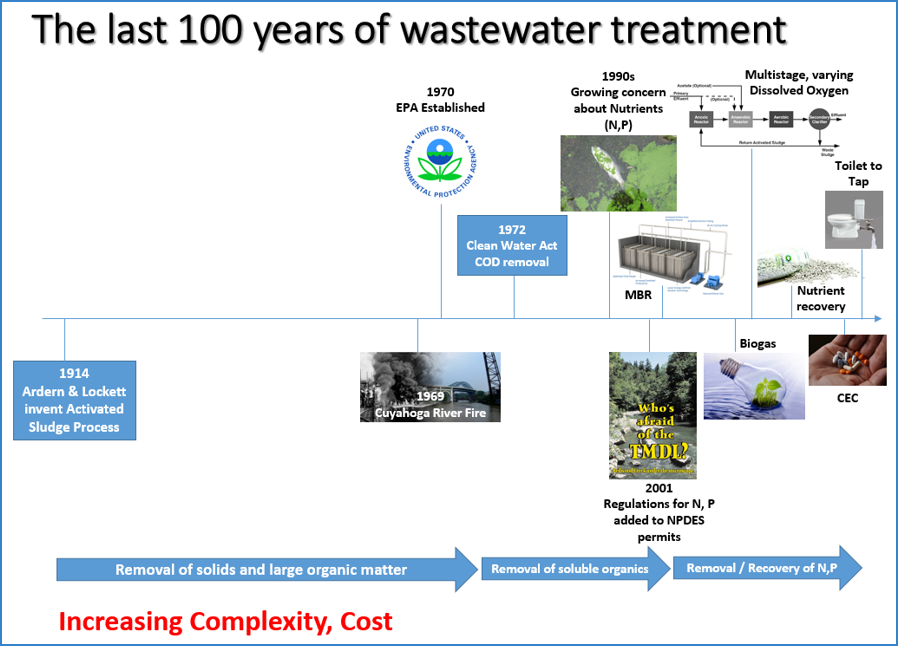
In the United States, the water treatment industry took off in a big way with the enactment of the clean water act in 1972. Now, all communities were required to do water and wastewater treatment. Tens of thousands of water and wastewater plants were built, and existing facilities were upgraded to meet the new requirements. A crop of 20, 30 and 40 year olds signed up to become operators. Now, those pioneering operators are silver haired, and starting to retire (see graphic below). This age group makes up well over 60% of the operator population in many facilities.
The environmental utility sector has an informal apprenticeship based training model. New operators learn from older operators. This group is now retiring – with their process knowledge and experience locked up in their minds. As an industry, we do not have good knowledge management practices. Each facility pretty much has to figure things out for themselves.
While industry wide certification and licensing programs help ensure that operators have some necessary skill sets and process knowledge, each treatment plant is unique, and learning must be customized for a particular facility.
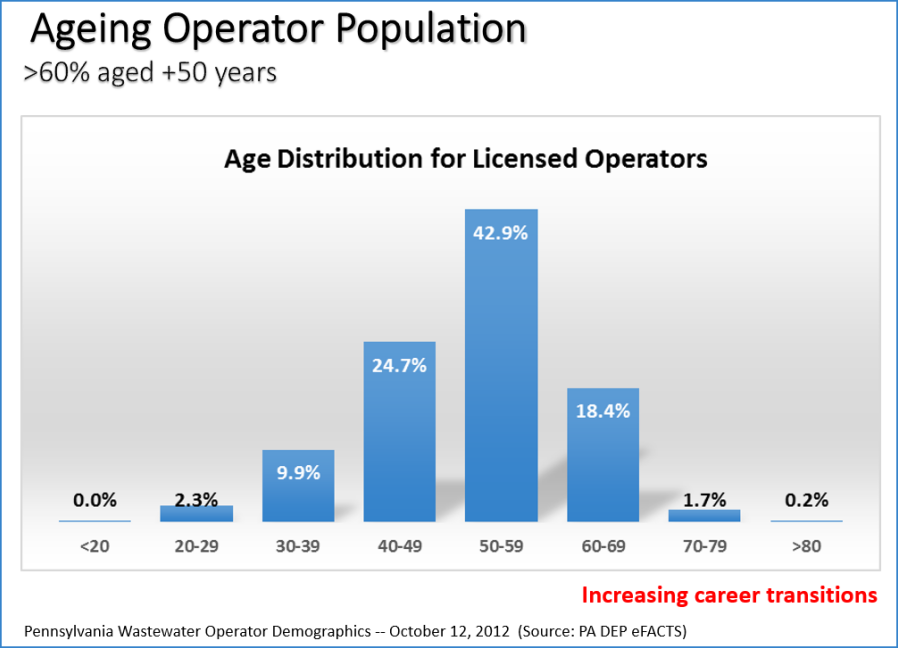
In the airline industry, pilots must first learn to fly in simulators before they are put in an actual air craft. Even experienced pilots must still routinely meet some training hour requirements in simulators. In the nuclear industry, simulator based instruction is a key part of an operator's required training.
The common thread between the airline and nuclear industries is the fact that both industries cannot afford any margin of error. A pilot cannot learn to land on the job – that will need to be honed in a simulator. A nuclear plant operator cannot afford to wait until a critical incident happens before understanding what steps will need to be taken to maintain safe operations.
There is also no margin for error in the water and wastewater industry. Our facilities are regulated, and every deviation from permitted values in the air emissions, liquid discharge or solids make up might be reportable incidents. Worse, the violations could even lead to public health & safety hazards.
For the last decade, Hydromantis has led the way in developing 3D simulators in the utilities industry. The process starts when a calibrated computer model of the facility is developed using Hydromantis' GPS-XTM process modeling platform. Next, a bird's eye view or SCADA interface shots of the facility are taken. These are then used to develop a 3D or SCADA interface that has the exact look and feel of the facility's treatment process or SCADA screens. We call this operational tool, SimuWorksTM.
All the operational changes that are made in the facility can be done using the SimuWorksTM platform – with the exact same outcomes. The following case studies highlight the different applications of SimuWorksTM.
The Metropolitan Sewer District of Greater Cincinnati (MSDGC) in Ohio State and Pima County Regional Wastewater Reclamation Department in Arizona State operate multiple facilities that address the sewage treatment needs of millions of customers.
Over the last decade, Hydromantis has supported both utility agencies in developing plant wide process models and 3D interfaces in SimuWorksTM.
The resulting effect has been an explosion of new technologies and processes. Membrane bioreactors, denitrification filters, biofilm media reactors, thermal hydrolysis, advanced oxidation, granular sludge systems – have now moved from laboratories squarely into the heart of the wastewater treatment process.
In both districts, the simulators have been successfully used to support the following applications.

Bird's eye view of a wastewater plant in Cincinnati and the representation of the plant in SimuWorksTM

Plant overview and SimuWorksTM interface for the Tres Rios Wastewater facility in Pima County, Arizona
Ontario Clean Water Agency (OCWA) is the largest operator of water and wastewater facilities in the province of Ontario. The agency is a trainer for the Ministry of the Environment's mandatory certification renewal courses. OCWA partnered with Hydromantis Environmental Software Solutions to develop a SimuWorksTM based interface that could be used as a basis for the certification program as well as operator training at their facilities.
The SimuWorksTM platform replicates SCADA and human machine interface (HMI) systems at specific OCWA facilities. The interface allows users to review and test a variety of operational variables.
The tool has been used by operators and managers to identify and validate plant optimization and cost-saving strategies, trouble shoot process issues, analyze projects and operational risks, and forecast plant capacity and maintenance needs.

Operators at the Belleville (Ontario) Water Control Plant work on a troubleshooting scenario during a Sewage Simulator Solutions Course using the SimuWorksTM platform
Competitors in the annual WEF Operations Challenge now participate in a simulator enabled process control event based on Hydromantis' SimuWorksTM platform. According to Mike Ross, Chair of the WEF Ops Challenge Process Control Event, "the incorporation of a simulator based platform into the WEF Operations Challenge is a reflection of the recognition that simulation is a process skill."
In the event, competitors are presented with operational challenges that they are required to solve. The issues they are required to deal with range from aeration limitations, to nutrient removal, biological and chemical phosphorus removal, equipment shut off, off line aeration tanks and clarifiers, etc.
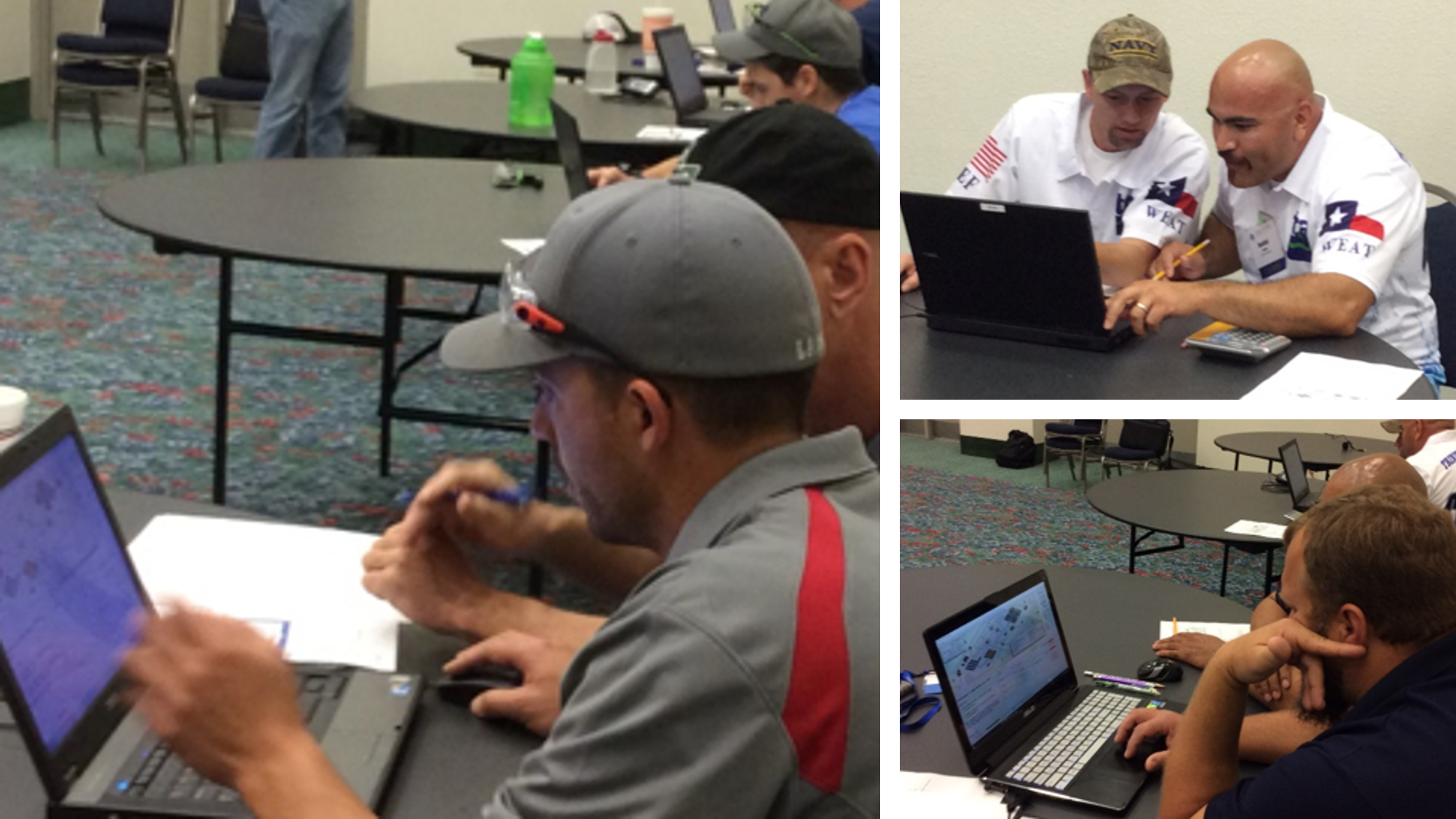
Competitors working on the simulator based Process Control Event at the Water Environment Association of Texas (WEAT) Regional Operators Callenge Event in Fort Worth, Texas in April 2016
Simulation-based training tools provide a sophisticated, yet readily accessible method for supporting succession planning, enhancing process knowledge, optimizing operations and implementing process strategy in an experiential, risk-free manner. SimuWorksTM can be deployed as a full-scale replica of an actual wastewater facility plant layout or the facility's SCADA system. The platform offers a user-friendly, customized interface that replicates not only the physical look and feel of the operator control interfaces at the facility, but also incorporates all of the operational variables that can be changed or monitored at the facility.
In summary, the benefits of simulators for training include:
By providing these benefits, simulators enable less experienced operators to fill vacancies in existing operators' pools more readily, and they can be used for getting new or seasoned operators familiar with new processes. Furthermore, simulators enable operations to be reviewed, repeated and varied until they become ingrained in the operator and internalized.
Want to Know More?
To find out more about how Hydromantis can support your process simulation and operator training needs, please email info@hydromantis.com
On Sunday March 13th, 2016 the wastewater industry crossed a major new threshold. For the first time in the history of our profession, simulation software was incorporated into the industry's most high profile, competitive event – the WEF Ops Challenge, during the South Carolina Regional Qualifying Event.
Read on to find out how operations teams from around the world are demonstrating that simulation based process control has come of age in the wastewater industry.
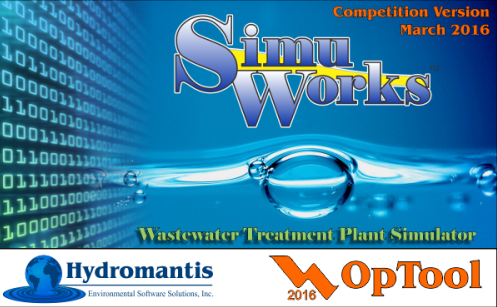
The Water Environment Federation's Operations Challenge (Ops challenge) is THE premier competitive event for operators in the global wastewater industry. The Ops Challenge competition tests the skills of operators in five (5) events that include – safety, laboratory, process control, collection systems and maintenance. Each participating team is sponsored by a WEF Member Association or recognized Operator Association.
Starting with regional events in the US, Canada and Germany, teams compete for a place in the finals, which take place during the annual WEFTEC event. The WEFTEC 2015 event had 44 competing team, including two from Germany. Winners are determined by a weighted point system for five events (collection systems, laboratory, process control, maintenance and safety), each designed to test the diverse skills required for the operation and maintenance of wastewater treatment facilities, collection systems and laboratories.
About a year ago, the WEF Operations Challenge committee expressed their vision for the inclusion of a simulation based challenge into the process control event. The process control part of the test has traditionally been a paper and pencil test.
Hydromantis was uniquely positioned to make this vision become a reality. For the last decade, we have pioneered the development of "flight simulator" styled platforms that provide facilities with 3D process simulator interfaces that can be used for operator training, facilitating plant optimization, enabling "what-if" analysis and supporting facility planning.

Bird's eye view of a wastewater plant vs 3D version of the Plant in Hydromantis' SimuWorksTM Platform
Just like a "Flight Simulator" the OpTool provides users with a realistic three (3) dimensional operational environment. Hydromantis' platform for the WEF Ops Challenge called the "OpTool" provides multiple challenge questions (poor BOD removal, Biological and Chemical Phosphorus removal, Nitrification failure, energy and chemical cost optimization, etc.) that feature realistic operational issues that the operators are required to address in order to bring the facility into compliance. The OpTool also features a countdown clock. To make the required operational changes, operators click on the relevant unit processes (e.g., aeration tanks, sludge wastage tanks, clarifiers, etc.), make the required adjustments and run the simulator. The real life implications of taking the specific actions are then reflected in the simulation output.
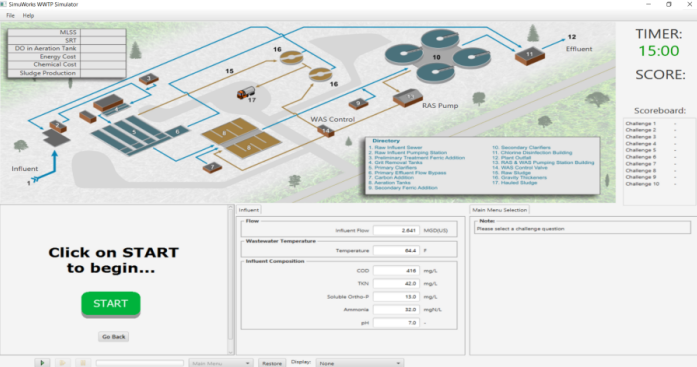
An Example Screenshot of the OpTool

Teams Taking the Ops Challenge Simulation Event
Simulation programs like the OpTool are the future of our industry. As regulations become more stringent and facilities are increasingly adopting new technologies and operational strategies to meet nutrient removal or resource recovery goals at their facilities, simulators that allow operators to be trained in a risk way, while also providing a platform for process optimization will become increasingly integrated into plant operations.
As they have always done, the industry leading operators who compete in the WEF Operations Challenge are blazing the train and demonstrating that process simulation is indeed a process skill, and that they have what it takes to master this platform for enhancing operations.
Want to Know More?
To learn more about how this tool can support your operations, please email snowling@hydromantis.com